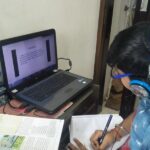Many students think the best way to prepare for a math exam is to reread their notes and look over solved examples. Unfortunately, this kind of passive review often creates a false sense of confidence. You feel like you “recognize” the material, but when the test arrives, it is hard to solve problems on your own. A far more powerful strategy is active recall—the habit of forcing your brain to retrieve information without looking at the answer first. When combined with regular practice and good organization, active recall can dramatically improve math exam performance. Many learners store their practice worksheets, problem sets, and formula sheets as PDFs and later organize them with PDFmigo.com.
What Is Active Recall?
Active recall means testing yourself instead of simply rereading material. In math, this means:
- Trying to solve problems from memory
- Writing formulas without looking
- Explaining steps out loud before checking a solution
- Using flashcards with questions on one side and answers on the other
Every time you force your brain to remember, you strengthen the memory and build confidence in solving problems by yourself.

Why Active Recall Works So Well in Math
Math exams rarely ask you to repeat definitions; they ask you to use concepts to solve problems. Active recall prepares you for this by:
- Training your brain to recognize problem types quickly
- Helping you remember formulas under pressure
- Revealing which topics you do not fully understand yet
- Building speed and accuracy through repetition
Step 1: Make a List of Key Topics and Formulas
Start by listing the major topics that will appear on the exam, such as:
- Linear equations
- Quadratic functions
- Systems of equations
- Inequalities
- Exponents and radicals
- Word problems
Under each topic, write the key formulas and typical problem types. This creates a roadmap for your revision.
Step 2: Turn Formulas and Steps Into Flashcards
Active recall works best when information is broken into small questions. For example, make flashcards like:
- Front: “Quadratic formula” – Back: “x = (-b ± √(b² – 4ac)) / 2a”
- Front: “Slope formula” – Back: “(y₂ – y₁) / (x₂ – x₁)”
- Front: “Steps to solve 2x + 5 = 11” – Back: “Subtract 5, then divide by 2”
Test yourself by looking at the question side and writing the answer from memory before flipping the card.
Step 3: Practice With Blank Sheets (No Notes Allowed!)
Choose a topic and set a timer for 15–20 minutes. On a blank sheet of paper:
- Write every formula you can remember for that topic
- Solve practice problems without looking at notes or examples
- Show every step, even if you are not sure
Afterward, compare your work with your notes or textbook. Circle mistakes and note which formulas you forgot. This feedback tells you exactly what to study next.
Step 4: Use Past Papers and Timed Practice
Past exams and sample tests are perfect for active recall because they simulate the real thing. Try this routine:
- Choose one section of a past exam.
- Set a timer (for example, 25 minutes).
- Work through the problems without notes.
- Mark your answers afterward and analyze mistakes.
Focus especially on problems you got wrong. Ask yourself, “What step did I miss?” or “Which formula should I have used?”
Step 5: Space Out Your Review Sessions
Active recall becomes even stronger when combined with spaced repetition. Instead of doing one long study session, spread shorter sessions over several days:
- Day 1 – Learn and practice new topics
- Day 2 – Test yourself on the same topics without looking at notes
- Day 4 – Repeat the test and add new problems
- Day 7 – Mix old topics with newer ones
Each time you successfully remember formulas and solve problems, your brain strengthens those memories.
Step 6: Organize Your Practice Materials
Over time, you may collect many practice sheets, online worksheets, and formula summaries in PDF format. It helps to keep them organized by topic—algebra, geometry, functions, and so on. Before big exams, students often combine their most useful practice pages into a single study packet using tools such as Merge PDF. This way, everything they need is in one place.
Step 7: Learn From Your Mistakes
Active recall will show you exactly where you struggle. Use a “mistake log” and write down:
- The problem you got wrong
- What you did
- What the correct step or formula was
- Why the mistake happened
Review this log regularly. Many students keep it as a PDF and file it together with their math notes using tools available at PDFmigo.com.
Step 8: Mix Different Types of Problems
On an exam, questions are often mixed—equations, graphs, word problems, and inequalities appear in random order. To prepare:
- Create small mixed sets of 5–10 questions from different topics.
- Time yourself and solve without notes.
- Score your work and note which topic needs more practice.
Step 9: Explain Concepts Out Loud
Teaching is one of the best forms of active recall. Pretend you are explaining the problem to a friend:
- Say what the question is asking.
- Explain which formula you chose and why.
- Talk through each step clearly.
If you cannot explain a step, that is a sign to review that concept more deeply.
Final Thoughts
Studying for math exams does not have to mean endless rereading and highlighting. By using active recall—testing yourself frequently, writing formulas from memory, solving problems without notes, and reviewing mistakes—you train your brain to perform under exam conditions. When combined with spaced practice and good organization of your PDF study materials, active recall can turn math from a stressful subject into one where you feel prepared and confident.














